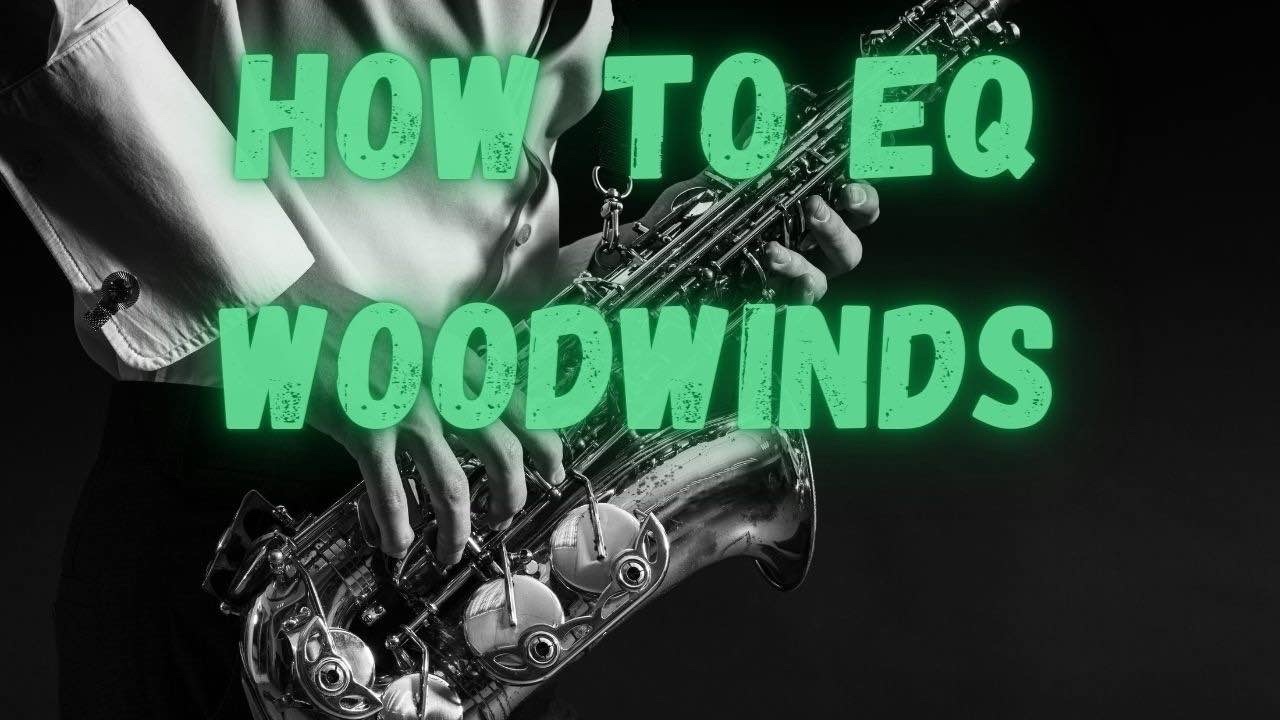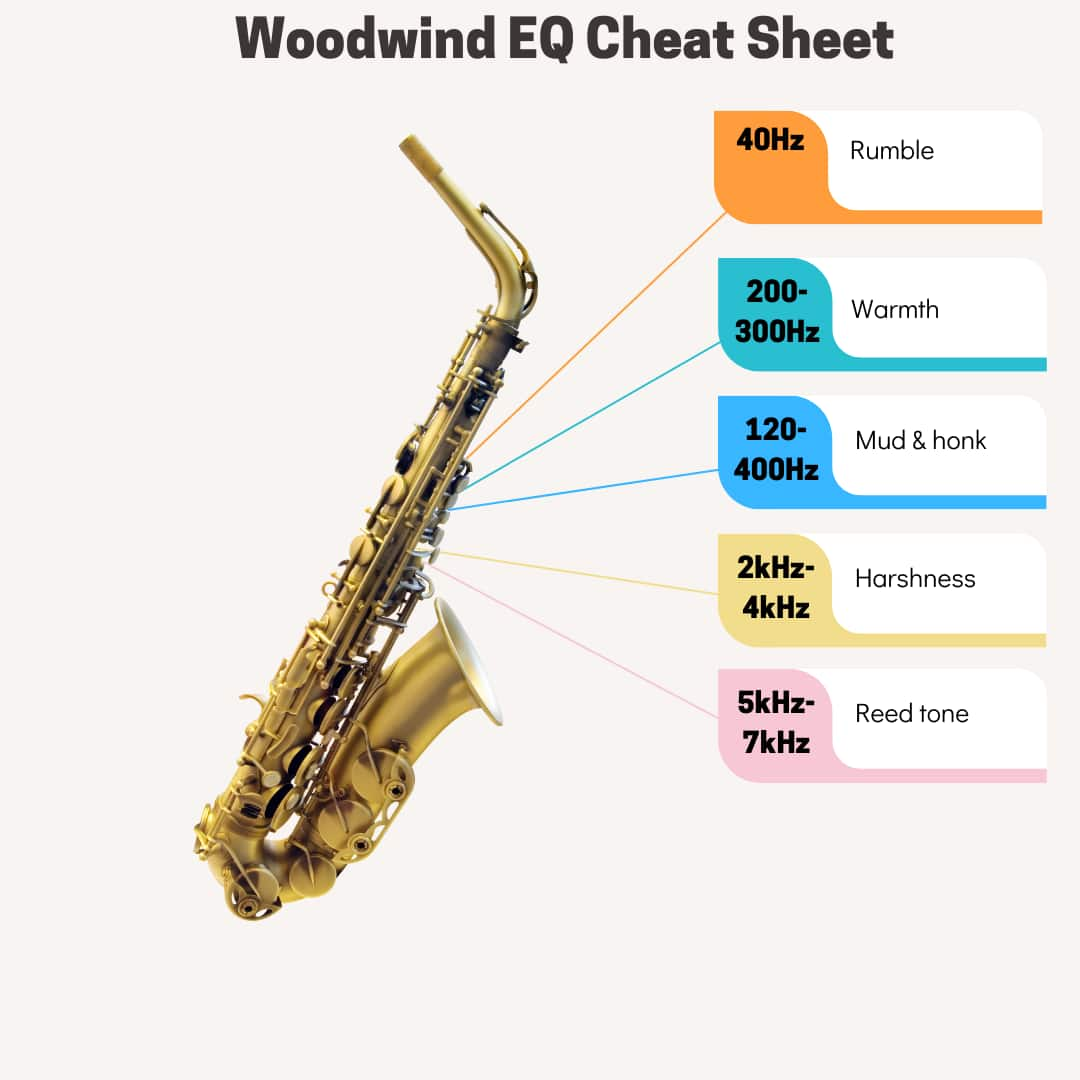How to EQ Woodwinds

Woodwinds, similar to the human voice, are very dynamic and have a large frequency range within which they live. An oboe is very different from a flute, which is very different from a saxophone, and so on.
However, the beauty of most woodwind instruments as individual instruments is that they have limited frequency ranges. If you have the chance to EQ each woodwind instrument separately rather than as an entire orchestral section, for example, then choosing the frequency range for them to live in is quite easy.
Today, we’re going to dive in and explore how you can approach EQ when it comes to specific woodwind instruments.
And at the end of this article, you'll find a free Brass EQ Cheat Sheet that you can right click to download!
Note: this article may contain affiliate links, which mean that I receive a commission for any purchases you make, at no added cost to you.
What Makes EQing Woodwinds Challenging
The major challenge when it comes to EQing woodwinds is that they are not as resilient to heavy EQ changes as their brass cousins. It is important to be delicate when EQing woodwind instruments so that you don’t remove any necessary tonal characteristics or make them sound unnatural (unless that is what you’re going for.)
Plus, because woodwinds are often dynamic instruments, some notes may sound louder and more prominent than others. The tonal characteristics of the room you recorded in can greatly impact the sound of the instrument.
In some cases, using dynamic EQ can be a better choice for dynamic woodwinds.
How To EQ Flute
The flute is a high-end instrument that often requires very little low-end information, especially in a busy mix. To help your flute soar above your mix, we recommend using a high-pass filter to get rid of any low-end noise and rumble.

You can often high-pass up to around 200Hz - 250Hz without taking away from the natural sound. If you’re dealing with a piccolo flute, you can often take this high-pass filter a bit higher to around 500Hz - 600Hz without impacting the natural sound.
Depending on how your flute was recorded, you may need to check for mud around 250Hz - 400Hz. If you’re EQing your flute within the context of a larger woodwind section, you probably don’t need this low mid-range.
The soft or percussive sound of a flute lies in the upper mid-range, around 2kHz-4kHz, which can be great for pushing your flute forward in places where it should be the focus.
Of course, because the flute is a high-end instrument, getting a bit of air, brightness, and presence is important. Similar to the human voice, we typically like to use a high shelf to boost around 10kHz-12kHz. Not only can this range help brighten a dull flute recording, but it can also help add that unique air sound that is so prominent in intimate flute recordings.
How To EQ Saxophone
The saxophone operates in the mid-range for the most part, though it depends on the type of saxophone that you’re working with. For example, an alto sax has a vastly different tonal character than a tenor sax or baritone sax.
More often than not, you can high-pass up to about 100Hz without doing any damage to the natural tone of the instrument.
Now, depending on the sax the player is using, whether that sax is a baritone or soprano sax, you will often find mud and honk anywhere from 120Hz - 400Hz.

A baritone sax will have mud much lower in the range compared to soprano sax. If you’re looking for mud, we recommend searching around the 240Hz - 400Hz range. However, if your sax recording sounds a bit thin and you want to beef it up, we recommend looking around the 120Hz - 240Hz range to add a bit of fullness.
Saxophones have a unique squawk to them, which are often responsible for harsh recordings. To get rid of this sometimes painful and shrill sound, you can cut a little bit from 1kHz - 2kHz.
From 5kHz - 7kHz lies reed noise. The reed is a thin piece of wood that vibrates when the player blows through the sax. Having too much reed noise in a recording is often undesirable, which is why many people look to cut around this range when EQing a saxophone. Make sure to use a narrow Q factor when cutting here so you don’t cut into the presence of the instrument.
How To EQ Oboe
The majority of the oboe fundamentals live in the 200Hz - 2kHz range. We like to think of the oboe as the mid-range-dominant instrument in a standard orchestral setting. More often than not, you won’t find a ton of useful information below 200Hz, which is why it’s a good idea to use a high-pass filter to get rid of it.

Mud can be a problem with a lot of oboe recordings, which you can often find between 200Hz - 400Hz. Use a moderate Q setting, and don’t cut too much if you want to keep the sound of the instrument as natural as possible.
If you notice that your oboe recording sounds a bit harsh, you can cut anywhere from 2kHz - 4kHz.
How To EQ Clarinet
The clarinet is a delicate instrument that doesn’t take too well to heavy EQ settings, which is why you must be very cautious when EQing it.
The first thing you’ll probably want to do when EQing clarinet is get rid of any low-end rumble. You can typically high-pass anywhere from 120-140Hz to get rid of rumble and clean up noise in the low-end. Doing so can help you fit your clarinet better in your mix.

You’ll often find mud in the clarinet throughout the low mid-range, spanning from about 140Hz - 300Hz. When approaching a muddy clarinet recording, we recommend using a narrow Q factor so that you don’t remove too much of the body.
Clarinet extends well into the high range, so feel free to accentuate any highs with a high shelf boost from 8kHz and up.
How To EQ Bassoon
When approaching the bassoon with EQ, you want to take the same kind of caution that you take with the clarinet. However, the bassoon holds down the low-end better than a clarinet, which is why you shouldn’t cut out as much low-end, especially when it comes to an orchestral setting.
Start by getting rid of unnecessary low-end rumble by high-passing anywhere from 50Hz-60Hz. Don’t use a steep dB per octave setting or you could end up creating low-end resonance.
One of the biggest problems with the bassoon is that there is often lots of buildup in the low mid-range, which can create a muddy recording. To get rid of this mud, you’ll have to look between 60Hz - 250Hz. Use a moderate Q setting and don’t cut too much.

The bassoon often doesn’t need tons of high-end, especially in a concert setting. In the realm of woodwinds, it operates like a bass, meaning you can typically get rid of the top-end without impacting the sound of the instrument.
We’ll usually take a low-pass filter down to about 6kHz to get rid of any air noise on top of the recording. Not only does this clear up any unnecessary top-end noise, but it also helps make room for upper mid-range instruments, such as the flute and clarinet.
Note that a contrabassoon will often need more upper mid-range to cut through a mix, so don’t chop off too much of the highs in the case you’re EQing one.
Questions?
Please let me know if you have any questions or comments about how to EQ Woodwinds in the comments below! I'll be sure to respond to you! And don't forget to grab the free Woodwind EQ cheat sheet at the end of the article!
How to use EQ Guides
To help you get the most out of your EQ plugins, we've put together these detailed guides to teach you how to use EQ on some of the most popular instruments.
- How to Mix with EQ
- Tips for EQing piano
- Electric guitar EQ tips
- How to EQ acoustic guitar
- How to EQ bass guitar
- How to EQ drums
- How to EQ vocals
- How to EQ woodwinds
- How to EQ strings
- How to Use Mid-Side EQ
- 3 Powerful Ways to Use Dynamic EQ
- How to EQ Loops
- How to EQ Reverb
- How to EQ Percussion

From a Frustrated Producer in a Ragtag Bedroom Studio to Major Placements on TV Earning $1,000s!
My name is Evan, and I've been making music since around 3rd grade. I'm from San Diego, California, but I've lived in Washington, DC for the last 20 years.
While I still have a full-time day job, I have created systems that have allowed me to produce dozens of songs a year in my spare time.
My songs have been on Netflix, TV shows like the 90 Day Fiance, an award-winning indie film, and NPR’s “All Thing Considered.” They've also been streamed millions of times.
In addition to being a music producer, I am passionate about teaching people how they can make professional-sounding music and earn money licensing it, all in their spare time.
Thousands of musicians, like yourself, have trusted me to guide their musical journey. My YouTube videos have been watched nearly a million times. And my story has been in Forbes, Side Hustle Nation, and the Side Hustle School.






